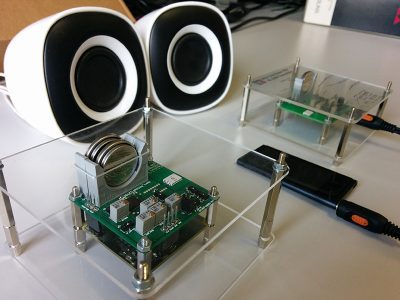
Activity Abstract
The focus of our research regards the design of CMOS integrated Impulse-Radio Ultra-Wide-Band (IR-UWB) systems for biomedical and portable applications. The transmitters and receivers are designed using both a standard RF design flow and an all-digital approach in which the logic gates are used as a design element. IR-UWB is a technology based on the transmission of short-duration pulses in the band 3.1-10.6GHz or in the low band 0-960MHz for the US. The core feature of this wireless technology is aggressive duty cycling, that is a pulse typically lasts only few nanoseconds duration compared to a symbol time, typically of 1 microsecond for moderate data rate applications.

For the standard RF flow the research regards the addressing of the typical challanges for the design of IR-UWB transceivers, in particular, interference robustness, energy per bit, power consumption, flexibilty and the elimination of power hungry synchronization blocks, also intervening at modulation level.
The objective is the development of a fully bio-inspired communication which resembles the way neurons and biological systems cells communicate, to favour low power consumption and flexibility.
The information transmission is typically organized into patterns and it is fully event driven, that is information is encoded in a delay between patterns is associated in an analog form.
For the digital flow we focus on the design of IEEE 802.15.6 compliant systems (packet-based), which operates using only logic gates and tolerating clock drifts and mismatch, hence, variability of the time-base at the source.
Digital pulsed receivers are technology and voltage scalable and have very low area, making them very attractive to biomedical miniaturized applications and Internet-of-Things (IoT). Thanks to their inherent modularity they can be very easily integrated in SoC with other circuits and systems on the same die.
The design of these radio system is in general achieved combining both physical implementation issues, communication and protocol-level impairments.
Published in:
- S. Sapienza, M. Crepaldi, P. Motto Ros, A. Bonanno, and D. Demarchi, “On Integration and Validation of a Very Low Complexity ATC UWB System for Muscle Force Transmission”, IEEE Trans. Biomed. Circuits Syst., pp. 497-506, May 2015
- A. Gabrielli, S. Bastianini, M. Crepaldi, G. D’Amen, D. Demarchi, I. Lax, P. Motto Ros, and G. Zoccoli, “Low power wireless ultra-wide band transmission of bio-signals”, Journal of Instrumentation, vol. 9, no. 1, p. C12002, Dec. 2014
- A. Gabrielli, M. Crepaldi, D. Demarchi, P. M. Ros, and G. Villani, “Wireless ultra-wide-band transmission prototype ASICs for low-power space and radiation applications,” Nuclear Instruments and Methods in Physics Research Section A: Accelerators, Spectrometers, Detectors and Associated Equipment, vol. 765, pp. 219–222, Nov. 2014
- M. Crepaldi and D. Demarchi, “A 130-nm CMOS 0.007-mm2 Ring-Oscillator-Based Self-Calibrating IR-UWB Transmitter Using an Asynchronous Logic Duty-Cycled PLL,” IEEE Trans. Circuits Syst. II, no. 99, pp. 237–241, 2013
- M. Crepaldi, S. Macis, P. M. Ros, and D. Demarchi, “A 0.07 mm2 Asynchronous Logic CMOS Pulsed Receiver Based on Radio Events Self-Synchronization,” IEEE Trans. Circuits Syst. I, vol. 61, no. 3, pp. 750–763, 2013
- M. Crepaldi, D. Daprà, A. Bonanno, I. Aulika, D. Demarchi, and P. Civera, “A Very Low-Complexity 0.3-4.4 GHz 0.004 mm2 All-Digital Ultra-Wide-Band Pulsed Transmitter for Energy Detection Receivers,” IEEE Trans. Circuits Syst. I, vol. 59, no. 10, pp. 2443–2455, 2012
- M. Crepaldi, M. Paleari, A. Bonanno, A. Sanginario, P. Ariano, D. H. Tran, and D. Demarchi, “A quasi-digital radio system for muscle force transmission based on event-driven IR-UWB,” presented at the Biomedical Circuits and Systems Conference (BioCAS), 2012 IEEE, 2012, pp. 116–119
Related videos:
Activity Keywords
- Impulse Radio
- Ultra-Wide-Band
- Event-driven
- Ultra-low power